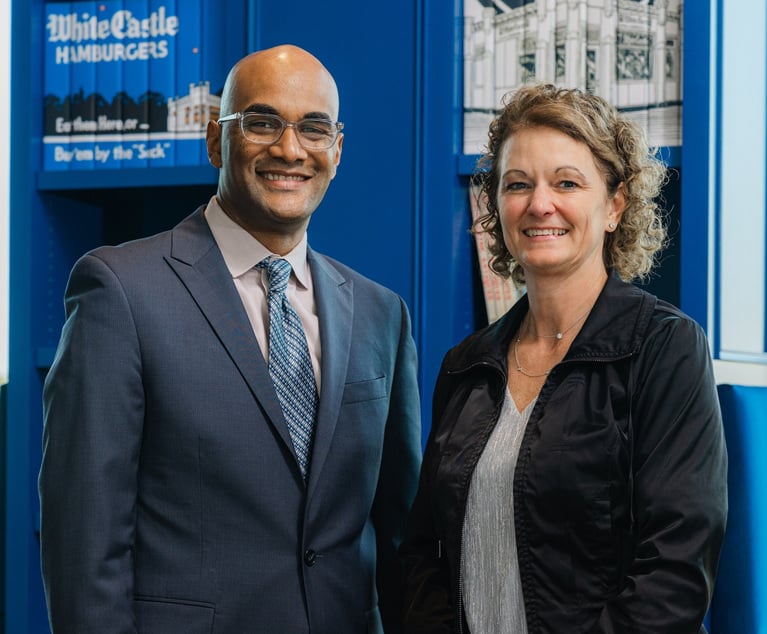Cooley plaintiffs face “uphill battle” in proving consumer protection claims
Law schools are on pins and needles as they wait for a federal judge to decide whether a lawsuit against Cooley Law School can proceed.
June 15, 2012 at 06:16 AM
13 minute read
The original version of this story was published on Law.com
Law schools are on pins and needles as they wait for a federal judge to decide whether a lawsuit against Cooley Law School can proceed.
Cooley was one of the first schools to face litigation from scores of law school graduates who are accusing their alma maters of misleading them about job opportunities. As of mid-March, 32 law schools faced such lawsuits. A judge tossed one of the suits, aimed at New York Law School, in late March.
The graduates in the Cooley suit say the school overstated the value of a Cooley law degree by not reporting statistics about how many employed grads had jobs that required law degrees and not specifying whether their jobs were full- or part-time. They seek $250 million in damages.
At a June 5 hearing, Judge Gordon J. Quist disagreed with Cooley's argument that the grads' lawsuit should be aimed at the American Bar Association and the NALP, which is the Association for Legal Career Professionals (formerly known as the National Association for Law Placement), which jointly set job-placement reporting rules. However, Judge Quist said the plaintiffs faced an “uphill battle” in arguing that Cooley's alleged misreporting violated the Michigan Consumer Protection Act.
“You say [the students] wanted to, in essence, get jobs in the legal profession and become high-skilled and high-paid lawyers in some law firms,” he told plaintiffs counsel. “To me, that's a business reason as distinguished from a consumer-protection reason.”
Regardless of whether Judge Quist allows the Cooley grads' lawsuit to proceed, law school students' frustration with the job market probably won't subside anytime soon. The NALP reported earlier this week that the employment rate for 2011 law school graduates is the lowest it has been since 1994. And in early May, Law School Transparency, a non-profit group that provides law education information to prospective law students, estimated that students in the class of 2015 will rack up an average of $195,265 in law school debt.
Read the Wall Street Journal for more about the Cooley lawsuit.
For more law school-related InsideCounsel stories, read:
Law school debt estimates exceed $200,000 for class of 2015
Judge tosses suit against New York Law School for misleading jobs data
20 more law schools to be sued for misleading jobs data
U.S. News & World Report names 2013 best law schools
Some law school grads head directly in-house
Law schools are on pins and needles as they wait for a federal judge to decide whether a lawsuit against
The graduates in the
At a June 5 hearing, Judge
“You say [the students] wanted to, in essence, get jobs in the legal profession and become high-skilled and high-paid lawyers in some law firms,” he told plaintiffs counsel. “To me, that's a business reason as distinguished from a consumer-protection reason.”
Regardless of whether Judge Quist allows the
Read the Wall Street Journal for more about the
For more law school-related InsideCounsel stories, read:
Law school debt estimates exceed $200,000 for class of 2015
Judge tosses suit against
20 more law schools to be sued for misleading jobs data
This content has been archived. It is available through our partners, LexisNexis® and Bloomberg Law.
To view this content, please continue to their sites.
Not a Lexis Subscriber?
Subscribe Now
Not a Bloomberg Law Subscriber?
Subscribe Now
NOT FOR REPRINT
© 2025 ALM Global, LLC, All Rights Reserved. Request academic re-use from www.copyright.com. All other uses, submit a request to [email protected]. For more information visit Asset & Logo Licensing.
You Might Like
View All
Meta Workers Aren't of One Mind on Company's Retreat From DEI, Fact-Checking

Private Equity-Backed Medical Imaging Chain Hires CLO, Continuing C-Suite Makeover

White Castle GC Becomes Chain's First President From Outside Family
Trending Stories
- 1No Two Wildfires Alike: Lawyers Take Different Legal Strategies in California
- 2Poop-Themed Dog Toy OK as Parody, but Still Tarnished Jack Daniel’s Brand, Court Says
- 3Meet the New President of NY's Association of Trial Court Jurists
- 4Lawyers' Phones Are Ringing: What Should Employers Do If ICE Raids Their Business?
- 5Freshfields Hires Ex-SEC Corporate Finance Director in Silicon Valley
Who Got The Work
J. Brugh Lower of Gibbons has entered an appearance for industrial equipment supplier Devco Corporation in a pending trademark infringement lawsuit. The suit, accusing the defendant of selling knock-off Graco products, was filed Dec. 18 in New Jersey District Court by Rivkin Radler on behalf of Graco Inc. and Graco Minnesota. The case, assigned to U.S. District Judge Zahid N. Quraishi, is 3:24-cv-11294, Graco Inc. et al v. Devco Corporation.
Who Got The Work
Rebecca Maller-Stein and Kent A. Yalowitz of Arnold & Porter Kaye Scholer have entered their appearances for Hanaco Venture Capital and its executives, Lior Prosor and David Frankel, in a pending securities lawsuit. The action, filed on Dec. 24 in New York Southern District Court by Zell, Aron & Co. on behalf of Goldeneye Advisors, accuses the defendants of negligently and fraudulently managing the plaintiff's $1 million investment. The case, assigned to U.S. District Judge Vernon S. Broderick, is 1:24-cv-09918, Goldeneye Advisors, LLC v. Hanaco Venture Capital, Ltd. et al.
Who Got The Work
Attorneys from A&O Shearman has stepped in as defense counsel for Toronto-Dominion Bank and other defendants in a pending securities class action. The suit, filed Dec. 11 in New York Southern District Court by Bleichmar Fonti & Auld, accuses the defendants of concealing the bank's 'pervasive' deficiencies in regards to its compliance with the Bank Secrecy Act and the quality of its anti-money laundering controls. The case, assigned to U.S. District Judge Arun Subramanian, is 1:24-cv-09445, Gonzalez v. The Toronto-Dominion Bank et al.
Who Got The Work
Crown Castle International, a Pennsylvania company providing shared communications infrastructure, has turned to Luke D. Wolf of Gordon Rees Scully Mansukhani to fend off a pending breach-of-contract lawsuit. The court action, filed Nov. 25 in Michigan Eastern District Court by Hooper Hathaway PC on behalf of The Town Residences LLC, accuses Crown Castle of failing to transfer approximately $30,000 in utility payments from T-Mobile in breach of a roof-top lease and assignment agreement. The case, assigned to U.S. District Judge Susan K. Declercq, is 2:24-cv-13131, The Town Residences LLC v. T-Mobile US, Inc. et al.
Who Got The Work
Wilfred P. Coronato and Daniel M. Schwartz of McCarter & English have stepped in as defense counsel to Electrolux Home Products Inc. in a pending product liability lawsuit. The court action, filed Nov. 26 in New York Eastern District Court by Poulos Lopiccolo PC and Nagel Rice LLP on behalf of David Stern, alleges that the defendant's refrigerators’ drawers and shelving repeatedly break and fall apart within months after purchase. The case, assigned to U.S. District Judge Joan M. Azrack, is 2:24-cv-08204, Stern v. Electrolux Home Products, Inc.
Featured Firms
Law Offices of Gary Martin Hays & Associates, P.C.
(470) 294-1674
Law Offices of Mark E. Salomone
(857) 444-6468
Smith & Hassler
(713) 739-1250







